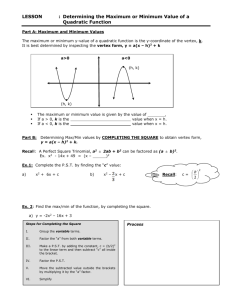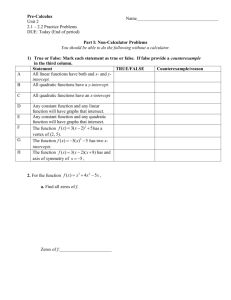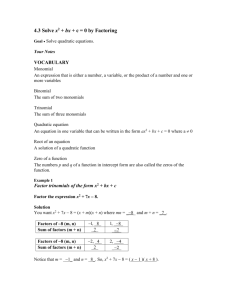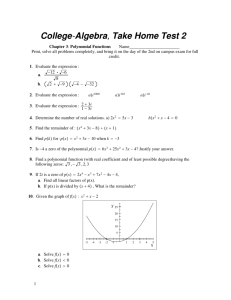Math Project - roqeeb giwa's senior portfolio
advertisement
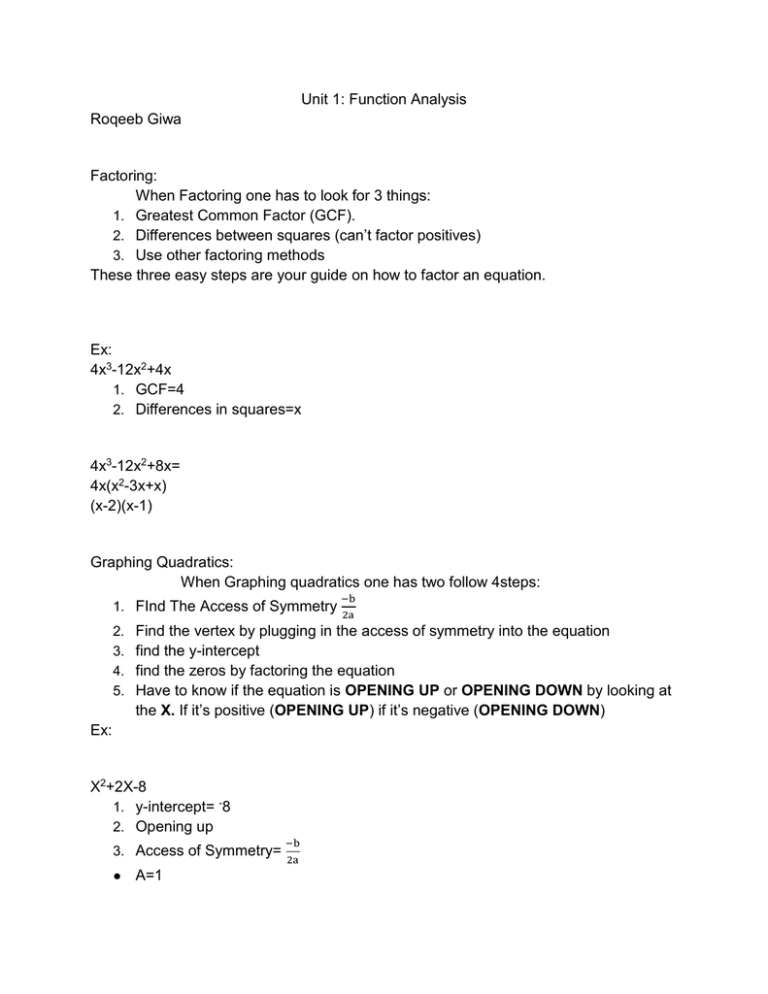
Unit 1: Function Analysis
Roqeeb Giwa
Factoring:
When Factoring one has to look for 3 things:
1. Greatest Common Factor (GCF).
2. Differences between squares (can’t factor positives)
3. Use other factoring methods
These three easy steps are your guide on how to factor an equation.
Ex:
4x3-12x2+4x
1. GCF=4
2. Differences in squares=x
4x3-12x2+8x=
4x(x2-3x+x)
(x-2)(x-1)
Graphing Quadratics:
When Graphing quadratics one has two follow 4steps:
1. FInd The Access of Symmetry
2.
3.
4.
5.
2a
Find the vertex by plugging in the access of symmetry into the equation
find the y-intercept
find the zeros by factoring the equation
Have to know if the equation is OPENING UP or OPENING DOWN by looking at
the X. If it’s positive (OPENING UP) if it’s negative (OPENING DOWN)
Ex:
X2+2X-8
1. y-intercept= -8
2. Opening up
3. Access of Symmetry=
●
−b
A=1
−b
2a
●
●
B=2
C=-8
Access of Symmetry= -22(1)=-22=-1
4. Vertex= (-1)2+2(-1)-8= -9 Vertex= (-1, -9)
5. Zeros= (x+4)(x-2)
Zeros are x=-4 x=2
Domain and Range:
When dealing with domain and Range you have to know three things:
1. Domain= The possible values of x (left to right)
2. Range= The possible values of Y (Down to Up)
3. The possible values that won’t make the equation negative.
4. if the domain or range starts at that value it gets a [ if it doesn’t it gets a (
EX:
y=x2+3
Domain: possible values are (-, )
● -squared is a positive so the equation can not be negative
Range: Possible values are [3, )
● The Range starts at 3 because that’s the y-intercept and it could be 3 so it has a [
End Behavior:
End Behavior refers to what happens to f(x) when x goes close to or When dealing with end behaviors all you pay attention to or care about in the equation
is the Dominant Term or Leading Term with the highest degree. End behaviors are
written like:
As x f(x)what the dominant term is if x was a positive number
AS x- f(x)what the dominant term is if x was a negative number
Ex.
3x5-2x4+100
● 3x5= dominant term with the highest degree
● x5 with x being a positive= positive
● x5 with x being a positive= negative
so:
As x, f(x)
As x, f(x)-
Zeros:
Zeros are called x-intercepts. It is what makes the function zero
Ex.
x2+5x+6=0
(x+2) (x+3)=0
x+2=0 x+3=0
Zeros are x=-2
x=-3
Increasing and Decreasing:
A function when the line on a graph is increasing or decreasing. if the line is
going from right to left its decreasing. From left to right its increasing
Ex:
the line is going from left to right so its increasing.
Discontinuity:
Discontinuities are spots on a graph of a function where there isn’t any value or
can’t be any value. There are three types of discontinuities.
Types of Discontinuities:
·
Jump- only happens in piece wise function where you have to jump from one
point to another
·
Hole- when there’s a point with no value
·
Infinite Discontinuity- Also knows as a vertical asymptote which is when there’s a
vertical imaginary line in a graph.
Ex.
Jump:
F(x)= { 3-x if x≤ 2
x if x> 2
There’s a jump from the point (2,1) to the point (2,2) because point (2,2) is a whole
which does not have a value.
Imaginary Numbers:
Imaginary numbers are numbers that cannot exist like √−9, √−16
These square roots can’t be solved because they have a negative in them.
Every negative square roots becomes √−1.√9. Then you can factor it since its a positive so it
becomes what was √3. √−1. The square root of negative one becomes i so you final answer
would be your the answer to the 3i
Rules of i:
i=√−1
i2= √−1.√−1= -1
i3= √−1.√−1.√−1= -i
i4= √−1.√−1.√−1.√−1=1
Ex:
√−16= 4i
(2-3i)+(6+5i)= 8+2i
Rationalize Denominator:
When you're trying to Rationalize denominators you can not have radicals on the
denominator. This means you can’t have the square root of a number as the denominator
Ex.
simplify
3 √5 3√5
. = 5
√5 √5
Even or Odd:
A function is even if f(-x) = f(x). That means that if you replace x with a -x, and then simplify the
function, you’ll end up with the same functions that you started with.
A function is odd if f(-x)= -f(x). That means that if you replace each x with -x, and then simplify
the function, you’ll get the opposite of the original function. (you’ll end up with -1.f(x))
Ex.
Even: f(x) = 5x2-4
to determine if its even or odd we need to evaluate f(-x) so we place -x into the function.
f(-x)= 5(-x)2-4
= 5x2-4
=f(x)
Since f(-x)= f(x) after we simplified, then f(x) is an even function.
Quadratic Formula:
Piecewise Functions:
When dealing with Piecewise functions one needs to know
● Greater than sign > (open point): increasing
● less than sign < (open point): decreasing
● Equal to sign = (closed point): lying flat across the x-axis
● less than or equal to≤(closed point): decreasing
● Greater than or equal to ≥(closed point): increasing
These signs allow you to know what is happening to your graph and what direction its going to.
piecewise functions are functions when you need to find x. which is what shows what direction
the graph goes and if its open or closed. You always plug in for x the number it’s greater than or
less than.
Ex.
f(x)={ 3-x if x ≤2
{ x f x> 2
1. for the first function you have to find what is x if it’s less than or equal to 2. What else is
equal to 2 but itself? so you replace x with 2 so the function looks like this.
f(x)={ 3-2 if 2 ≤2
={ 1 if 2 ≤2
so a point on the graph will be (2,1) with a closed point.
2. The second function is pretty simple. It’s asking what is x if its greater than 2, we don’t
know that so we just replace x with 2 itself so the function will look like this.
f(x)= {2 if 2>2
so another point on the graph will be (2,2) with an open point.
The graph will look like this:
Model Real World Data:
12 Basic Functions:
The Identity Function
● f(x)=x
● Domain:(-∞, ∞)
● Range: (-∞, ∞)
● Unbounded
●
Always increasing
Squaring Function
● f(x)=x2
● Domain:(-∞, ∞)
● Range: [0,8)
● Bounded Below
● Decreasing: (-∞,0)
●
Increasing:(0,∞)
●
Graph called Parabola
The Cubing Function
● f(x)=x3
● Domain:(-∞, ∞)
● Range:(-∞, ∞)
● Unbounded
● Always increasing
●
The origin is the point of reflection
The Reciprocal Function
● f(x)=1/x
● Domain:(-∞,0)u(0,∞)
● Range:(-∞,0)u(0,∞)
● VA: x=0 (y-axis)
● Horizontal Asymptote: y=0 (x-axis)
● Graph called a hyperbola
The Square Root Function
●
●
●
●
●
f(x)=√x
Domain:[0,∞)
Range:[0,∞)
Bounded Below (0,0)
Graph is top half of a sideways parabola.
Exponential Function
● f(x)=ex
● Domain:(-∞, ∞)
● Range:(0,∞)
● bounded below by y=0 (x-axis)
● Value of e ≈2.718
● Graph is half of a hyperbola
Natural Logarithm Function
● f(x)= Inx
● Domain:(0,∞)
● Range:(-∞, ∞)
● Bounded on the left by x=0 (y-axis)
● Inverse of exponential function
● Used to describe many real life phenomena including intensity of earthquakes (Richter
scale).
●
Rule of Domain for Logarithm= log≠or≠Neg
Sine Function
● f(x)= Sinx
● Domain:(-∞, ∞)
● Range:[-1,1]
● Periodic Function (repeats every 2πunits)
● Local Maximum π/2 +or- kπ, where k is an odd integer
● Local Minimum: kπ, where k is an integer
● Bounded
Cosine Function
● f(x)=Cosx
● Domain:(-∞, ∞)
● Range;[-1,1]
● Periodic Function (repeats every 2πunits)
● Local Maximum kπ, where k is an even integer
● Local Minimum: kπ/2 +or- kπ, where k is an odd integer
● Bounded
Absolute Value Function
● f(x)=|x|
● Domain:(-∞, ∞)
● Range:[0,∞)
● Bounded below at the origin
● V-shaped graph
Logistic Function
● f(x)=1/1+e-x
●
●
●
●
Domain:(-∞, ∞)
Range:(0,1)
Bounded
Model for many applications for biology (population growth) and business
Greatest Integer Function
● f(x)=[x]=int(x)
● Domain:(-∞, ∞)
● Range:All Integers
● Continuous at each non_integer value
● Jump discontinuity at each integer
● Also called “step” function
Fundamental Theorem of Algebra:
There are 3 things you need to know about the Fundamental Theorem of Algebra:
1. Its a polynomial function of degree n
2. has N numbers of Complex Zeros
↓
● A real or imaginary zero
3. Some zeros may repeat
Ex.
What are the roots of y2-56
(y+√56) (y-√56)
y=√56 y=-√56
Complex Conjugate Theorem:
Complex Conjugate Theorem are when a function has an imaginary zero in the form
a+bi. Then a-bi is also a zero.
Ex.
A polynomial function of degree 3 has zeros at x=5, x=i√5, and x=-i√5 write the function.
f(x)= (x-5) (x-i√5) (x+i√5)
f(x)=(x-5) (x2+5)
f(x)=x3-5x2+5x+25
Transformations:
When dealing with transformation all you care about is transforming a function to:
● x2+2= shift up (vertical)
● x2-2= shift down (vertical)
● 2(x)2= Vertical Strech
● ½(x)2= Vertical Shrink/Press
● (x+2)2= Shift left
● (x-2)2= Shift right
● -(x)2=Reflect over x-axis
● -(x)2= Reflect over y-axis
Ex.
What is the transformation of g(x)=x2+2
● The function is originally f(x)=x2
so the transformation is the function shifted up.
Model Real World Data:
When trying to model a real world data you need to know 4 things:
● The Asymptote
● The vertex
● The Quadratic Formula
Ex.
A model rocket launches from the roof of a building. it’s flight is modeled by h(t)=-5t2+30t+10,
where n=rocket h=height and t=time after the launch in seconds.
To find the time you have to find the asymptote
● h(t)=-5t2+30t+10
●
−30
−30
=
=3
2(−5) −10
so the time= 3 seconds
You have to find the height by finding the vertex
● h(t)=5(3)2+30(3)+10
● h(t)=55 ft so max height= 55ft
so vertex= (3,55)
To find n you have to do the quadratic formula
●
−30+/−√302 −4(−5)(10)
2(−5)
●
●
−30+/−√900+200
−10
−30+√1100
X=3.125
−10
−30−√900+200
−10
X=6.32
Then you find the domain which is [0, whenever the rocket hits the gound]
Identifying when a function is negative, positive, zeros:
is doing the quadratic formula and finding out if the square root part of it is positive,
negative or a zero which will make the whole function positive, negative or zero.
Ex.
f(x)=x2-8x+25
8+/−√82 −4(1)(25)
2(1)
f(x)=
8+/−√−36
2
f(x)=
because the square root part is negative then the whole function is negative.
Describing Functions:
When describing quadratic functions you need to know 5 facts:
● y-intercept
● opening up or down (use the dominant term)
● Vertex (x,y)
● x-intercept
● sketch graph
Ex.
f(x)=3x2+12x+11
● Y-intercept =11
● it is opening because the dominant term is positive
● the vertex is (-2,-1)
● To find the x-intercept is to do the quadratic formula and the x will be
−2+/−√3
3
X=
Rational Functions;
When dealing with Rational functions you need to know:
● What a discontinuity is
● where the zeros are
● Domain
● Range
● End behavior
Ex.
Graph the function f(x)=
●
●
●
●
●
2x2
on
9−x2
the coordinate plane below:
Domain:(-∞, -3)u(-3,3)u(3,∞)
Discontinuity: Infinite Discontinuity at x=3 and x=-3
The zeros: x=0
Range: (-∞,∞)
End Behavior: as x→ ∞, f(x)→-1
as x→ −∞, f(x)→-1
so the graph will look like this:
Quadratic Formula;
Also another way to find the zeros of a function when you cannot factor your zeros using
the Equation=
−b+/−√b2 −4ac
2a
Ex.
f(x)=x2+8x+15
−8 +/−√82 − 4(1)(15)
2
−8 +/−√64 − 60
2
x=
−8+/−2
2
x=-3 x=-5

